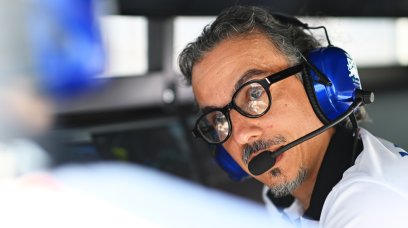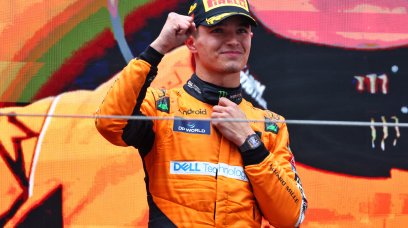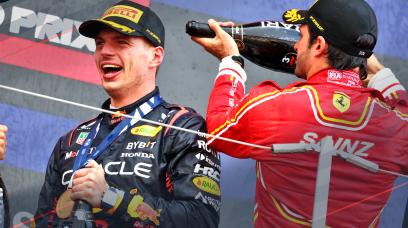Red Bull and Ferrari look like the real deal
After Ferrari's strong start in Barcelona, the Scuderia immediately picked up where they left off by consistently impressing throughout the Bahrain test. Not only did the F1-75 prove reliable throughout the entire six days of the pre-season, but Carlos Sainz and Charles Leclerc also kept the new machine at or near the top of the times – seemingly at will. The car also looks smooth on track, with the porpoising significantly reduced from what was seen in Barcelona, and the fact that the car performed so well at two circuits with vastly different conditions bodes well for the Italian squad. After years of jokes at their expense about "next year", could 2022 finally be that year? Certainly not if Red Bull have anything to say about it. After being there-or-thereabouts throughout the Barcelona test, and through the first half of the Bahrain test, Red Bull slowly upped the ante in the final hours. After the furore of Mercedes' updates at the start of the test, the evolved version of the RB18 finally hit the track on the final day as Sergio Perez spent Saturday morning fettling the upgrades before Max Verstappen took it out for some fast runs at the very end. Verstappen's times were eye-opening, although possibly flattered to deceive – particularly as Leclerc's best time was set on the Soft C4 compound, versus Verstappen on the softest compound of all. How Red Bull and Ferrari addressed their porpoising issues from Barcelona appears critical to them unlocking this extra pace, which seemingly puts both teams a step ahead of Mercedes for the start of the season.
Mercedes' complaints appear to be genuine
While Mercedes' W13 didn't look quite as dramatically poor on track by the final hours of the Bahrain test, there appears to be little doubt that the reigning Constructors' World Champions aren't in as happy a place as they usually are at the start of the season. Mercedes are well known for taking the underdog stance and downplaying their strengths but, for once, the complaints of Lewis Hamilton and George Russell might have some merit as there was little disguising the ride problems and constant understeer their car displayed on track. While the issues seemed to dissipate somewhat on the performance-focused runs towards the end of Saturday, with lighter fuel loads and softer tyres, these conditions aren't representative of those found during a Grand Prix. Looking past the doom and gloom cast by Hamilton and Russell, Andrew Shovlin appeared considerably more optimistic about the handling of the W13. There's also the fact that Ferrari themselves appear to be taking the Mercedes approach of downplaying their own competitiveness, with Sainz even trying some diversionary tactics of branding their complaints as "typical Mercedes" in a bid to keep the focus on the reigning champions. It's perhaps fairer to say that Mercedes are somewhere in the middle – not quite as bad as the drivers are alleging, but maybe not as good as the team would have hoped for. Given that the usual standards set by Mercedes for themselves involve crushing 1-2 finishes, the extent of how bad their problems are remains to be seen in a competitive outing. The big question mark is whether Mercedes have opted for the wrong design direction and, if they have, how quickly it can be rectified given the budget and wind tunnel constraints now in place.
There's still plenty of scope for different designs
It seems silly now, given that the 2022 cars no longer look strange out on track, but it wasn't that long ago that there were genuine concerns that all the field could look very similar under their liveries this year. With the technical regulations tightened up to the point of being highly prescriptive, the fear was that all could look like simple tweaked versions of the demonstration car rolled out by Formula 1 at last year's British Grand Prix. Thankfully, that has proven to be far from the case – with all of the top teams employing very different interpretations of the regulations. The Mercedes is the obvious example, with the team paring off the W13's sidepods to give the car an extremely streamlined (if slightly melty-looking) shape. Contrast that with the curvaceous, albeit bulkier, Ferrari. Strip both cars back to bare carbon, and it would still be extremely easy to tell them apart. Aside from appearances, there's also the question mark over which design is likely to yield the biggest returns as the regulations begin to mature. Will it be the approach taken by Adrian Newey and Pierre Wache with their RB18? Have James Allison and Mike Elliott struck a hammer blow with the W13 once Mercedes get the porpoising under control? Or have Enrico Cardile's department at the Gestione Sportiva got it right for Ferrari? It's a hugely intriguing part of the year, and now it's time to see who has made the best call.
Anything can happen in F1, and it usually does!
Of all the headlines I didn't expect to write this week, this particular story about Kevin Magnussen topping the times on the second day is probably the lead contender. F1's relentless, ever-evolving nature means that, sometimes, the most unusual circumstances imaginable actually come to fruition. For instance, who would have ever believed Fernando Alonso signing a return to McLaren while Ron Dennis was still in charge? Or, even weirder, when Markus Winklehok led by 30 seconds, on his debut, in a Spyker, at the start of the second lap of the 2007 European Grand Prix? Magnussen's F1 career, a month ago, was dead in the water, with absolutely zero reason to believe that that would change. However, the sequence of events triggered by Russia's commencement of military action in Ukraine has led to Magnussen returning to the sport with a new, long-term deal, in what is surely one of the most popular drive announcements for a long time. After a pre-season marred by bad news and controversy, the Bahrain test initially began in the same way as the team's freight got stuck in the UK. But, with Haas granted track time to make up for the moment of force majeure , Magnussen marked his return to an F1 cockpit by setting the fastest lap time on Friday. While clearly flattering to deceive, Haas' performances during testing, combined with Magnussen seemingly convinced by the team's potential to the extent he was willing to walk away from Chip Ganassi Racing's sportscar entries and Peugeot's Hypercar programme, suggest the VF-22 could be capable of some surprises this season. Can anyone honestly say they could see Nikita Mazepin managing the same?
Reserve drivers are still an essential contingency for F1 teams
While the immediate panic about having a reserve driver to hand appears to have eased in line with the slow ebbing away of the COVID-19 pandemic, the past few weeks have shown that it should remain a top priority. First was the situation for Haas where they required a driver at short notice to replace the ousted Mazepin. With the team finding fortune in a willing Magnussen, it certainly might not have fallen as tidily for them had the Danish driver not wanted to return. Pietro Fittipaldi, although a solid and competent stand-in, clearly wasn't the team's ideal choice. The Brazilian-American driver went through a rollercoaster as it first appeared as though a full-time seat might be available, before the dashing disappointment of having that struck down to just a solitary testing appearance. But Haas, at least, had their own dedicated reserve driver to fall back on if required. McLaren losing Daniel Ricciardo's services for the Bahrain test resulted in what could have been an overwhelming and hugely tiring few days for Lando Norris, had the team not encountered various issues that hampered their programme. With the Bahrain GP now looming, with the potential that Ricciardo might not be fully recovered from COVID-19, the team's reliance on Mercedes' own reserves meant that Formula E Champion Nyck de Vries was their only option (due to Stoffel Vandoorne's participation in the 12 Hours of Sebring) – a driver without recent familiarity of McLaren, or even F1. Since then, Alpine have offered up Oscar Piastri, their own reserve driver, as an option for McLaren – a considerably more attractive offer, given his recent experience in Alpine's F1 car, as well as being the reigning Formula 2 champion. While the likes of Red Bull, Ferrari and Aston Martin have extremely strong reserves to hand, drivers who could be reasonably expected to score points from the get-go, some teams perhaps need to take the role of the reserve a little more seriously – especially given that COVID-19 is still a threat that could prevent a driver from racing.
Most read



















